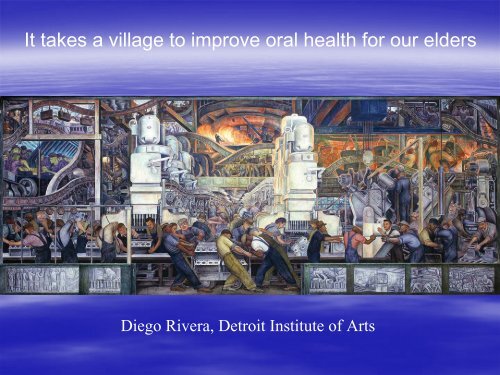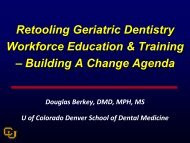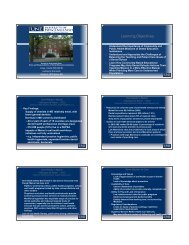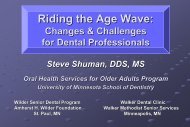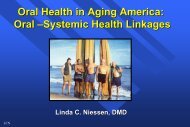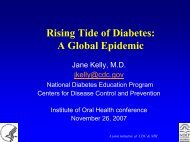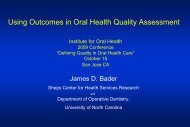Conference PPT - Institute for Oral Health
Conference PPT - Institute for Oral Health
Conference PPT - Institute for Oral Health
Create successful ePaper yourself
Turn your PDF publications into a flip-book with our unique Google optimized e-Paper software.
It takes a village to improve oral health <strong>for</strong> our elders<br />
Diego Rivera, Detroit <strong>Institute</strong> of Arts
The cost of care<br />
(and who pays <strong>for</strong> it)<br />
Judith A. Jones, D.D.S., M.P.H., D.Sc.D.<br />
Professor and Chair,<br />
Department of General Dentistry<br />
Boston University
Options<br />
• Extending dental insurance into retirement<br />
• Inclusion of OH into comprehensive plans<br />
• Retiree plans <strong>for</strong> selected groups<br />
• Optional part “D” <strong>for</strong> dental in Medicare<br />
(minus the donut)<br />
• Prepaying dental care during employment<br />
• EldersHIP like SCHIP
Agenda<br />
• What is the big picture?<br />
• How does dental fit in?<br />
• Financing – what is paid; by whom?<br />
• Reimbursement – what are the options?<br />
• IOM Principles <strong>for</strong> eliminating<br />
underinsurance<br />
• Examples?
Elders use of care 3.6* over 50y<br />
70<br />
60<br />
58%<br />
50<br />
40<br />
30<br />
20<br />
10<br />
0<br />
16%<br />
1957-58 1975 1999 2005<br />
All<br />
45-64<br />
65+<br />
Source: NCHS
Context<br />
• 37.260 million elders in 2006; 12.4%<br />
• 58% of elders used dental care in 2005<br />
• 76 million baby boomers start turning<br />
65 in 2011<br />
• Elders’ economic and educational<br />
diversity<br />
<strong>Health</strong>, United States 2007
75% of elders: Household income < $50k<br />
(in 2005)<br />
National <strong>Health</strong> Expenditures, 2005<br />
$2 trillion<br />
16% of the Gross Domestic Product<br />
$6697 / person on average<br />
–55% from private funds<br />
–45% from public funds<br />
–25.2% of federal expenditures<br />
–15.2% of state expenditures<br />
<strong>Health</strong>, United States 2007
National <strong>Health</strong> Expenditures 2005<br />
Home health<br />
2.4%<br />
Medical<br />
Products<br />
2.9%<br />
Rx<br />
10.1%<br />
Govt/private<br />
Admin<br />
7.2%<br />
Gov Public<br />
<strong>Health</strong><br />
2.8%<br />
Hospital<br />
30.8%<br />
Nursing<br />
Home<br />
6.1%<br />
Other<br />
Personal<br />
2.9%<br />
Dental<br />
4.4%<br />
Other Prof<br />
2.9%<br />
MD<br />
21.2%<br />
<strong>Health</strong>, United States 2007
National Dental Expenditures 2005<br />
$86.6 billion (now pushing $100B)<br />
4.4% of the personal health care<br />
expenditures<br />
296.5 million people<br />
$292.30 / person, on average<br />
$444 / person who used care<br />
<strong>Health</strong>, United States 2007
Financing versus Reimbursement<br />
• Financing – what comes in; to whom?<br />
– mechanisms by which money enters the<br />
health care system to pay <strong>for</strong> the<br />
delivery of services by varying types of<br />
providers (dentists, hospitals, MDs…)<br />
• Reimbursement – how?<br />
– mechanisms by which providers are paid
Physician Services by Source of<br />
Payment, 2005<br />
Medicaid<br />
7.1%<br />
Other Public<br />
8%<br />
Out of Pocket<br />
10.1%<br />
Medicare<br />
21.2%<br />
Other<br />
Private<br />
6.4%<br />
Private <strong>Health</strong><br />
Insurance<br />
48.3%<br />
<strong>Health</strong>, United States 2007
Dental Services by Source of<br />
Other Private<br />
Percent of Care by Source of Payment<br />
60<br />
<strong>Health</strong>, United States 2007; CMS 2004<br />
50<br />
40<br />
30<br />
20<br />
10<br />
0<br />
MD (2005)<br />
DMD(2002)<br />
All Public Funding Medicare Medicaid<br />
Private<br />
Out of Pocket
Dental visit by age and insurance<br />
(2000 MEPS)<br />
50<br />
40<br />
30<br />
20<br />
10<br />
0<br />
Percent with a visit<br />
All ages<br />
65+<br />
65+ Medicare<br />
65+ Medicare +<br />
private<br />
65+ Medicare +<br />
public
Plan Type by ability to pay (SES)<br />
SES<br />
Public<br />
LOW<br />
Medicaid<br />
Medicare-D<br />
ELDERSHIP<br />
Private<br />
Out of<br />
Pocket<br />
Low
Plan Type by ability to pay (SES)<br />
SES<br />
LOW<br />
MEDIUM<br />
HIGH<br />
Public<br />
Private<br />
Medicaid<br />
ELDERSHIP<br />
Medicare-D<br />
Medicare - D?<br />
Medicare Advantage<br />
HSA,…<br />
Extending plans into<br />
retirement, Tricare,<br />
AARP, …<br />
Out of<br />
Pocket<br />
Low<br />
Moderate<br />
High
Questions to think about<br />
• What do we need to know to better plan<br />
<strong>for</strong> oral health <strong>for</strong> all older Americans?<br />
• Financing – What options do we have?<br />
• Reimbursement - What options can we<br />
envision?<br />
• How can health literacy be brought to bear<br />
on the access issues?
Principles <strong>for</strong> Eliminating Uninsurance<br />
(IOM: Insuring America’s s <strong>Health</strong>)<br />
• <strong>Oral</strong> health care coverage should be:<br />
– Universal<br />
– Continuous<br />
– Af<strong>for</strong>dable to individuals and families<br />
– Af<strong>for</strong>dable and sustainable <strong>for</strong> society<br />
– Enhance health and well-being by<br />
promoting access to high quality care
Principles <strong>for</strong> eliminating uninsurance<br />
(IOM: Insuring America’s s <strong>Health</strong>)<br />
• Coverage should be universal<br />
– Are individuals required to obtain<br />
coverage?<br />
– Are employers required to offer it?<br />
– Who is eligible / not eligible?<br />
– What type of coverage is it?<br />
– Is it easy to enroll?<br />
– Are there subsidies <strong>for</strong> low income<br />
elders?
Principles <strong>for</strong> eliminating uninsurance<br />
(IOM: Insuring America’s s <strong>Health</strong>)<br />
• <strong>Oral</strong> health care should be continuous<br />
– Is re-enrollment enrollment required? How frequently?<br />
– How streamlined is re-enrollment?<br />
enrollment?<br />
– What happens to people who change jobs?<br />
– What happens to people with change in<br />
income?<br />
– Does it continue into retirement?<br />
– What about early retirees?
Principles <strong>for</strong> eliminating uninsurance<br />
(IOM: Insuring America’s s <strong>Health</strong>)<br />
• <strong>Oral</strong> health care coverage should be af<strong>for</strong>dable<br />
– How much do elders contribute to their<br />
premiums?<br />
– What premiums, co-payments and<br />
deductibles?<br />
– Do they vary with income, health status,<br />
functional status?<br />
– Do they vary by venue (nursing home, home<br />
health care?)<br />
– Are subsidies available? How can elders<br />
qualify <strong>for</strong> them?
Principles <strong>for</strong> eliminating uninsurance<br />
(IOM: Insuring America’s s <strong>Health</strong>)<br />
• <strong>Oral</strong> health care insurance should be af<strong>for</strong>dable /<br />
sustainable <strong>for</strong> society<br />
– How realistic are estimates of use and cost?<br />
– Does everyone contribute? If not, why?<br />
– Are revenues stable in tough economic times?<br />
– Are utilization controls / cost-controls controls built in?<br />
– Does the benefit package encourage cost-<br />
effective services?<br />
– Does the strategy emphasize simplicity and<br />
efficiency?
Principles <strong>for</strong> eliminating uninsurance<br />
(IOM: Insuring America’s s <strong>Health</strong>)<br />
• <strong>Oral</strong> health care insurance should enhance health<br />
and well-being<br />
– Is the care high quality, effective, efficient, safe,<br />
timely, patient-centered and equitable?<br />
– Are preventive and screening services covered<br />
and encouraged?<br />
– Are there incentives to avoid overuse /<br />
inappropriate use of services?<br />
– Are there incentives to offer high quality care<br />
consistent with scientific evidence?
Assumptions<br />
• Hypothetical population of 1million elders<br />
– 54% are 65-74<br />
– 34% are 75-84 and<br />
– 13% are 85+<br />
• 95% community dwelling<br />
• 5% will be in institutions<br />
• 80% have 1 chronic condition<br />
• 50% have at least 2 chronic conditions
Assumptions<br />
• 10% have diabetes<br />
• 10% have dementia and<br />
• 10% have visual impairments<br />
• 25% have hearing impairment<br />
• 50% have arthritis and<br />
• 50% need assistance with 1 or more<br />
Activities of Daily Living
Development of a statewide<br />
Elders’ <strong>Oral</strong> <strong>Health</strong> Insurance<br />
Program similar to SCHIP<br />
Stephen A. Eklund, DDS, DrPH<br />
University of Michigan<br />
Delta Dental Plans of Michigan, Ohio, and<br />
Indiana
• Sponsoring Organization<br />
– Likely joint federal state program, as is<br />
SCHIP<br />
• Plan development<br />
– Would come from legislation that<br />
developed overall program design, and<br />
appropriated necessary federal funds<br />
– If like SCHIP, it would be optional <strong>for</strong><br />
states to implement<br />
– If linkage to Medicaid is an option <strong>for</strong><br />
states, this could diminish the<br />
effectiveness of the program Eklund, 2004
• Population covered<br />
– Poor<br />
• Below federal poverty level<br />
• 10.4% of 65+ population in 2002<br />
• Approximately 3.7 million people in 2002<br />
– Near-poor<br />
• between poverty level and 125% of<br />
poverty<br />
• 6.4% of 65+ population in 2002<br />
• Approximately 2.3 million people in 2002<br />
Eklund, 2004
• Plan type (HMO, PPO, Indemnity, etc.)<br />
–Likely to vary by location between<br />
and within states<br />
• HMO and PPO will depend on state<br />
and local panel availability<br />
• Panel size will affect access<br />
Eklund, 2004
• Level of care covered<br />
–Diagnostic and preventive services,<br />
emergency, and basic restorative<br />
services most likely<br />
• This population is likely to have high<br />
levels of untreated need<br />
• Level of care covered will have major<br />
effect on cost<br />
Eklund, 2004
• Who pays the premiums?<br />
–Federal and state funds pay all or<br />
most of the premium<br />
•By definition, this population does<br />
not have resources to pay all of the<br />
premium<br />
•Could be some small premium<br />
contribution, especially from near-<br />
poor<br />
Eklund, 2004
Out of pocket cost to participant<br />
–annual premiums<br />
• This population is likely to have high<br />
levels of untreated need<br />
• Level of care covered will have major<br />
effect on cost<br />
• Even a small contribution could be a<br />
significant part of the total cost<br />
Eklund, 2004
• Out of pocket cost to participant (cont.)<br />
–annual premiums (continued)<br />
• even a small contribution could be a<br />
significant part of the total cost<br />
–copays<br />
• probably not on diagnostic, preventive,<br />
and emergency services<br />
• should be small, if at all, especially <strong>for</strong><br />
poor<br />
Eklund, 2004
Out of pocket cost to participant (cont.)<br />
–non-covered services<br />
• crowns, could profoundly affect cost,<br />
especially considering likely need in this<br />
population<br />
–annual maximum<br />
• modest annual maximum, e.g., $600,<br />
could be an effective cost control<br />
Eklund, 2004
• Annualized cost per participant<br />
–Will depend on many factors<br />
• level of care covered<br />
• who enrolls (adverse selection)<br />
• access<br />
• utilization<br />
–Examples<br />
• $300/user/year, with 40% utilization, would cost<br />
$120/enrolled/year ($10 pmpm)<br />
• $450/user/year, with 60% utilization, would cost<br />
$270/enrolled/year ($22.50 pmpm)<br />
Eklund, 2004
• Advantages<br />
– If done well, would get significant<br />
amounts of care to the elderly population<br />
most in need<br />
– Splitting cost 4 ways, would make cost<br />
more palatable <strong>for</strong> all involved<br />
(fed/state/premium/copay)<br />
– Total cost (to be split) only .75 to 2.0<br />
$Billion<br />
– Will encourage more providers to devote<br />
a significant part of their practices to<br />
elderly patients<br />
Eklund, 2004
• Disadvantages<br />
– Total cost .75 to 2.0 $Billion<br />
– Voluntary enrollment will miss many people,<br />
and could lead to adverse selection and an<br />
unfavorable cost situation<br />
– Means testing <strong>for</strong> eligibility and possible<br />
premium contribution will be cumbersome<br />
– Separation from medical coverage could<br />
perpetuate misperception that oral health care<br />
is not a mainstream part of health care<br />
– Linkage to Medicaid could limit effectiveness<br />
Eklund, 2004
Elders’ <strong>Oral</strong> <strong>Health</strong> Summit<br />
What do we need to know to eliminate disparities in access to and<br />
outcomes of oral health care in elders?<br />
Max Anderson<br />
Delta Dental Data Analysis Center
Prepaid Insurance Plans<br />
• Sponsoring organization (existing or<br />
potential) Washington Dental Service or<br />
any other Insurance Plan or Financial<br />
Institution.<br />
• Plan development and history – Project at<br />
WDS, not yet implemented<br />
Delta Dental Data Analysis Center
PRINCIPLES<br />
• Annuity Product<br />
• Voluntary <strong>for</strong> Groups<br />
• $2000/Yr maximum<br />
• Minimum pay-in period<br />
• Coverage options<br />
– 100/100/50<br />
– 100/80/50<br />
Delta Dental Data Analysis Center
EXPENSE / PATIENT / YEAR BY AGE<br />
Delta Dental Data Analysis Center<br />
$700<br />
$600<br />
Diagnostic Preventive Basic Rest. Major Rest.<br />
Endo. Perio. Prosth. Bridges<br />
<strong>Oral</strong> Surgery Ortho.<br />
$500<br />
$400<br />
$300<br />
$200<br />
$100<br />
$0<br />
Up<br />
to 5<br />
6 to<br />
11<br />
12<br />
to<br />
19<br />
20<br />
to<br />
24<br />
25<br />
to<br />
29<br />
30<br />
to<br />
34<br />
35<br />
to<br />
39<br />
40<br />
to<br />
44<br />
45<br />
to<br />
49<br />
50<br />
to<br />
54<br />
55<br />
to<br />
59<br />
60<br />
to<br />
64<br />
65<br />
to<br />
69<br />
70<br />
to<br />
74<br />
75<br />
to<br />
79<br />
80<br />
to<br />
84<br />
85<br />
to<br />
89<br />
90<br />
to<br />
94<br />
95+
Prepaid Insurance Plans<br />
• Universal?<br />
– Individuals required to have it? No – Voluntary<br />
– Employers required to offer it? No<br />
• Eligibility –<br />
– Population covered – Currently insured with<br />
minimum pay in period<br />
– Population not covered – Uninsured?<br />
• Easy to enroll? Yes<br />
• Subsidies? Not as configured but no reason<br />
not to in a different labor market<br />
Delta Dental Data Analysis Center
Prepaid Insurance Plans<br />
• Continuous<br />
– Re-enrollment enrollment required? No<br />
– Is re-enrollment enrollment streamlined?<br />
– Change of jobs? Yes<br />
– Change of circumstances?<br />
– Retirement? Starts paying out on<br />
retirement (65)<br />
– Early retirement? Pay at 65.<br />
• Choice of dentists – Yes, POS program<br />
Delta Dental Data Analysis Center
Prepaid Insurance Plans<br />
• Af<strong>for</strong>dable <strong>for</strong> individuals and families?<br />
–Contributions to the premium? 100%<br />
plus accrued interest<br />
–What types of premiums, deductibles<br />
and co-payments are included? Normal<br />
100/80/50 or 100/100/50 (model)<br />
–Are subsidies available? Perhaps<br />
• How to qualify? .. To be defined<br />
Delta Dental Data Analysis Center
Prepaid Insurance Plans<br />
• Out of pocket costs to participants<br />
–Annual premiums –<br />
• while working but not while retired<br />
–Co-payments<br />
–<br />
• Yes at plan’s s designed level<br />
• Annualized cost per participant – yes, $25.00 /<br />
year admin charge<br />
Delta Dental Data Analysis Center
Prepaid Insurance Plans<br />
• Af<strong>for</strong>dable / sustainable <strong>for</strong> a segment of society.<br />
• Are assumptions / estimates realistic?<br />
– Cost/person – Calculate ad libitum<br />
• Level of care covered?<br />
– Choice at market rates<br />
• Who bears the main burden? –<br />
– The employee while working.<br />
• Are revenues stable in tough times?<br />
– Yes, on the output side.<br />
Delta Dental Data Analysis Center
Prepaid Insurance Plans<br />
• Af<strong>for</strong>dable / sustainable <strong>for</strong> society – yes <strong>for</strong><br />
this sector<br />
• Are utilization controls built in? Yes<br />
• Are cost-controls controls built in? Yes<br />
• Does the plan encourage cost-effective<br />
services? At market.<br />
• Is the plan administratively efficient? Yes<br />
Delta Dental Data Analysis Center
Prepaid Insurance Plans<br />
• Enhance health and well-being by promoting access to high-<br />
quality care<br />
– Effective, efficient, safe, timely, patient-centered<br />
and equitable –<br />
• Standard plans<br />
– Incentives <strong>for</strong> screening and prevention?<br />
• Standard plans<br />
– Incentives to avoid overuse?<br />
• As in standard plans<br />
– Incentives to providers to offer high quality care<br />
consistent with scientific evidence?<br />
• Standard payment as it evolves.<br />
Delta Dental Data Analysis Center
Prepaid Insurance Plans<br />
• Advantages<br />
– Good <strong>for</strong> one segment<br />
– Helps plan <strong>for</strong> the future<br />
– fixed income<br />
– May improve access to<br />
care (removes barrier)<br />
– Easy to administer<br />
– Easily available<br />
– Reinsurance covers risk<br />
– Annuity to heirs<br />
– Many vendors -<br />
competition<br />
• Disadvantages<br />
– Limited market<br />
– May be hard to<br />
understand<br />
– It’s s not free<br />
– Locked in <strong>for</strong> payment<br />
Delta Dental Data Analysis Center
Elders’ <strong>Oral</strong> <strong>Health</strong> Summit<br />
Optional Part “D2”<br />
For Dental Medicare<br />
What do we need to know to eliminate<br />
disparities in access to and outcomes of oral<br />
health care in elders?<br />
Manski 2004
Plan 1 - PPO<br />
• Sponsoring organization (existing or<br />
potential)<br />
–Private Sector in conjunction with<br />
CMS/Medicare<br />
Manski 2004
PPO<br />
• Advantages<br />
– Reasonable cost from network providers<br />
– Wide panel selection<br />
• Disadvantages<br />
– High cost <strong>for</strong> out- of - network providers<br />
– Limited panel selection<br />
Manski 2004
PPO<br />
• Plan Summary<br />
– Premium of about $16 a month or $200 a year<br />
per person (final premium to be actuarially<br />
determined).<br />
– Limited to Panel Providers<br />
– First dollar coverage <strong>for</strong> prevention (with limits<br />
and exclusions to be determined by profession<br />
and experts)<br />
– Pay the first $250 <strong>for</strong> non preventive services.<br />
Manski 2004
PPO<br />
• Plan Summary<br />
– Pay 20% of discounted fees <strong>for</strong> restorative and<br />
surgical services above $250.<br />
– Pay 50% of discounted fees <strong>for</strong> other services<br />
above $250.<br />
– Annual limit of $1500<br />
– Additional options to help low income persons<br />
pay the out-of<br />
of-pocket costs.<br />
– Subsidy available to pay <strong>for</strong> premiums <strong>for</strong> low<br />
income persons.<br />
Manski 2004
Plan 3 – HSA<br />
<strong>Health</strong> Savings Accounts<br />
• Sponsoring organization (existing /<br />
potential)<br />
– Private Sector in conjunction with<br />
CMS/Medicare<br />
Manski 2004
HSA<br />
• Advantages<br />
–Simple<br />
–Freedom of Choice<br />
• Disadvantages<br />
–Limited assistance <strong>for</strong> high out-<br />
of-pocket expenditures<br />
Manski 2004
HSA<br />
• Plan Summary<br />
– No Premium – Subscriber places self<br />
determined amount of funds in a tax free<br />
account<br />
– Pay 100% of non-discounted fees with tax<br />
free dollars.<br />
– Freedom of Choice<br />
Manski 2004
HSA<br />
• Plan Summary (cont.)<br />
– Additional options to help low income<br />
persons pay the out-of<br />
of-pocket costs.<br />
– Supplemental coverage available to<br />
assist with high out-of<br />
of-pocket<br />
expenditures (above $1500/yr) with<br />
premium to be actuarially determined by<br />
experts<br />
Manski 2004
Lowell D. Daun, DDS<br />
Voluntary, Self-Insured<br />
Dental Programs<br />
For Individuals
100% enrollee-paid dental plans<br />
• Dental insurance generally limited to groups,<br />
employers, etc.<br />
• <strong>Oral</strong> health is important <strong>for</strong> all age groups --<br />
<strong>for</strong> smiling, eating, overall health<br />
• Demand exists <strong>for</strong> dental insurance in the<br />
older population<br />
Courtesy of Lowell D. Daun, DDS
What consumers want ?<br />
• Af<strong>for</strong>dable cost<br />
• Comprehensive benefit<br />
• Access to quality care<br />
• Customer service<br />
• Value<br />
Courtesy of Lowell D. Daun, DDS
TRICARE Retiree Dental Program<br />
• Dental program <strong>for</strong> retired members of<br />
uni<strong>for</strong>med services and their family<br />
members<br />
• Mandated by Congress<br />
• Implemented by the DOD<br />
• 100% premium paid by enrollees<br />
Courtesy of Lowell D. Daun, DDS
TRICARE Retiree Dental Program<br />
• Delta awarded initial 5-year 5<br />
contract in<br />
1998 <strong>for</strong> basic program<br />
• Program enhanced in 2000<br />
• Delta awarded second 5-year 5<br />
contract in<br />
2003<br />
Courtesy of Lowell D. Daun, DDS
Popular changes to contract<br />
• Coverage <strong>for</strong> crowns, dentures, bridges and<br />
2 cleanings per year<br />
• Orthodontics added (including adults)<br />
• Annual maximums increased<br />
• Waiting period <strong>for</strong> major restorations<br />
reduced to 12 months<br />
• Enrollment commitment reduced to 12 mos<br />
• Increased Participating Dentist Locations<br />
Courtesy of Lowell D. Daun, DDS
Daun, cont.<br />
• Advantages: Available to individual<br />
population that has not been served <strong>for</strong> on<br />
an individual basis<br />
• Disadvantage: It is not universal and is not<br />
available to everyone. Ex. Parents,<br />
grandparents, the disabled, college kids and<br />
older siblings.
Options <strong>for</strong> financing/reimbursement<br />
• Extending dental insurance into retirement<br />
• Inclusion of OH into comprehensive plans<br />
• Retiree plans <strong>for</strong> selected groups<br />
• Optional part “D” <strong>for</strong> dental in Medicare<br />
• Prepaying dental care during employment<br />
• EldersHIP like SCHIP
Plan Type by ability to pay (SES)<br />
SES<br />
LOW<br />
MEDIUM<br />
HIGH<br />
Public<br />
Private<br />
Medicaid<br />
ELDERSHIP<br />
Medicare-D<br />
Medicare - D?<br />
Medicare Advantage,<br />
PPO, HSA<br />
Extending plans into<br />
retirement, TRICARE,<br />
AARP, Prepaid<br />
Out of<br />
Pocket<br />
Low<br />
Moderate<br />
High


